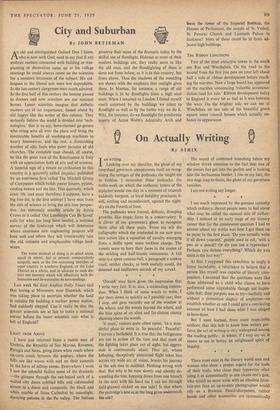I have just returned from a motor tour of Umbria,
the Republic of San Marino, Ravenna, Perugia and Siena, going down white roads where ox-carts creak between the poplars, where the hills are like waves with surf on their summits In the form of hilltop towns. Everywhere I went I saw the splendid Italian sense of the dramatic the glimpse through the sun-baked arch of a walled city down cobbled hills and colonnaded streets to a dome and campanile., the black and White marble of Siena Cathedral by moonlight, decaying palaces in the Po valley. The Italians preserve their sense of the dramatic today by the skilful use of floodlight. Hideous as most of their modern buildings are, they really seem to like the old ones, and the floodlighting of them is done not from below, as it is in this country, but from above. Thus the shadows of the moulding are shown with the emphasis that sunlight gives them. In Mantua, for instance, a range of old buildings is lit by floodlights from a high steel mast. When I returned to London I found myself much surprised by the buildings we select to floodlight as well as by the feeble way we do it. Why, for instance, do we floodlight the ponderous inanity of Aston Webb's Admiralty Arch and leave the tower of the Imperial Institute, the Houses of Parliament, the steeple of St. Vedast, St. Pancras Church and Lambeth Palace in darkness? Most of these could be lit from ad- jacent high buildings.


































 Previous page
Previous page